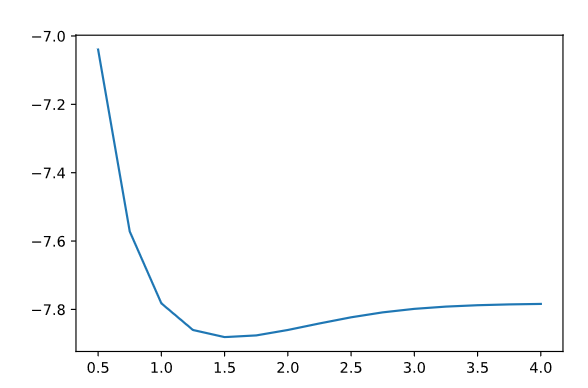I'm trying to implement the same Jupyter notebook Jin-Sung Kim gave in his YouTube video The Variational Quantum Eigensolver — Programming on Quantum Computers — Coding with Qiskit S2E4; however, I'm facing the error as below:
Error:
step 0
/Users/bambrozi/.local/share/virtualenvs/ibm-quantum-challenge-2020-ZWRg31rS/lib/python3.8/site-packages/qiskit/chemistry/core/hamiltonian.py:91: DeprecationWarning: The ChemistryOperator is deprecated as of Qiskit Aqua 0.8.0 and will be removed no earlier than 3 months after the release date. Instead, the FermionicTransformation can be used to transform QMolecules and construct ground state result objects.
super().__init__()
/Users/bambrozi/.local/share/virtualenvs/ibm-quantum-challenge-2020-ZWRg31rS/lib/python3.8/site-packages/qiskit/chemistry/core/hamiltonian.py:415: DeprecationWarning: Processing a dictionary result is deprecated, pass a (minimum) eigensolver result now.
warnings.warn('Processing a dictionary result is deprecated,'
---------------------------------------------------------------------------
TypeError Traceback (most recent call last)
<ipython-input-3-66becf9098c9> in <module>
13 # exact classical result
14 exact_result = NumPyMinimumEigensolver(qubit_op, aux_operators=aux_ops)
---> 15 exact_result = operator.process_algorithm_result(exact_result)
16
17 # VQE
~/.local/share/virtualenvs/ibm-quantum-challenge-2020-ZWRg31rS/lib/python3.8/site-packages/qiskit/chemistry/core/chemistry_operator.py in process_algorithm_result(self, algo_result)
88 return self._process_algorithm_result(algo_result)
89 else:
---> 90 lines, result = self._process_algorithm_result(algo_result)
91 result['algorithm_retvals'] = algo_result
92 return lines, result
~/.local/share/virtualenvs/ibm-quantum-challenge-2020-ZWRg31rS/lib/python3.8/site-packages/qiskit/chemistry/core/hamiltonian.py in _process_algorithm_result(self, algo_result)
374 # TODO return self._process_algorithm_result_excited_states(algo_result)
375 else:
--> 376 return self._process_algorithm_result_deprecated(algo_result)
377
378 def _process_algorithm_result_ground_state(self, algo_result: MinimumEigensolverResult) \
~/.local/share/virtualenvs/ibm-quantum-challenge-2020-ZWRg31rS/lib/python3.8/site-packages/qiskit/chemistry/core/hamiltonian.py in _process_algorithm_result_deprecated(self, algo_result)
419
420 # Ground state energy
--> 421 egse = algo_result['energy'] + self._energy_shift + self._ph_energy_shift
422 result['energy'] = egse
423 lines = ['=== GROUND STATE ENERGY ===']
TypeError: 'NumPyMinimumEigensolver' object is not subscriptable
Source-code:
# %%
import numpy as np
import pylab
import copy
from qiskit import BasicAer
from qiskit.aqua import aqua_globals, QuantumInstance
from qiskit.aqua.algorithms import NumPyMinimumEigensolver, VQE
from qiskit.aqua.components.optimizers import SLSQP
from qiskit.chemistry.components.initial_states import HartreeFock
from qiskit.chemistry.components.variational_forms import UCCSD
from qiskit.chemistry.drivers import PySCFDriver
from qiskit.chemistry.core import Hamiltonian, QubitMappingType
# %%
molecule = 'H .0 .0 -{0}; Li .0 .0 {0}'
distances = np.arange(0.5, 4.25, 0.25)
vqe_energies = []
hf_energies = []
exact_energies = []
# %%
for i, d in enumerate(distances):
print('step', i)
# set up experiment:
driver = PySCFDriver(molecule.format(d/2), basis='sto3g')
qmolecule = driver.run()
operator = Hamiltonian(qubit_mapping=QubitMappingType.PARITY,
two_qubit_reduction=True,
freeze_core=True,
orbital_reduction=[-3, -2])
qubit_op, aux_ops = operator.run(qmolecule)
# exact classical result
exact_result = NumPyMinimumEigensolver(qubit_op, aux_operators=aux_ops)
exact_result = operator.process_algorithm_result(exact_result)
# VQE
optimzer = SLSQP(maxiter=1000)
initial_state = HartreeFock(operator.molecule_info['num_orbitals'],
operator.molecule_info['num_particles'],
qubit_mapping=operator._qubit_mapping,
two_qubit_reduction=operator._two_qubit_reduction)
var_form = UCCSD(num_orbitals=operator.molecule_info['num_orbitals'],
num_particles=operator.molecule_info['num_particles'],
initial_state=initial_state,
qubit_mapping=operator._qubit_mapping,
two_qubit_reduction=operator._two_qubit_reduction)
algo = VQE(qubit_op, var_form, optimzer, aux_operators=aux_ops)
vqe_result = algo.run(QuantumInstance(BasicAer.get_backend('statevector_simulator')))
vqe_result = operator.process_algorithm_result(vqe_result)
exact_energies.append(exact_result.energy)
vqe_energies.append(vqe_result.energy)
hf_energies.append(vqe_result.hartree_fock_energy)
Thanks for the help!

